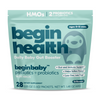How to Make Formula Feeding More Like Breastfeeding
share this article

Whether you're exclusively formula feeding or using it to supplement breastfeeding, many parents wonder: How can I give my baby the same nutritional and gut health benefits as breast milk?
While formulas can never replicate breast milk completely, there are smart, evidence-based ways to make formula feeding more like breastfeeding, especially when it comes to supporting your baby’s gut, immune system, and development.
Here’s how to bridge the gap with both nutrition and connection.
1. Look for Formulas With HMOs
One of the most important components of breast milk is human milk oligosaccharides (HMOs). These are prebiotic carbohydrates that nourish beneficial gut bacteria and support the development of a healthy microbiome. The most abundant and well-studied HMO is 2’-fucosyllactose (2’-FL).
While not all formulas include HMOs, a growing number now do. Studies show that infants fed formula with 2’-FL have gut bacteria and immune responses more similar to breastfed babies [1].
If your formula doesn’t include HMOs, consider adding a daily supplement like Beginbaby Prebiotic + Probiotic, which provides HMOs along with beneficial probiotics like Bifidobacterium lactis + infantis.
2. Add a Prebiotic + Probiotic Supplement
Breast milk naturally delivers both probiotics and prebiotics, helping populate the gut with good bacteria and feed them. Most formulas lack these microbiome-supporting elements, or include only one.
Supplements that include both prebiotics and probiotics—known as synbiotics—can help fill this gap. Products with clinically studied strains like B. infantis and B. lactis, along with HMOs have been shown to support healthy stooling patterns, gut colonization, and immune function [2].
3. Practice Responsive Feeding
One of the most important parts of breastfeeding is the bonding and responsiveness that happens during feeds. You can mimic this during formula feeds by:
-
Holding your baby skin-to-skin or in a cradled position
-
Switching sides during the feed, just like breastfeeding
-
Making eye contact and responding to hunger and fullness cues
-
Letting your baby control the pace of the feeding
This approach supports emotional development and helps babies regulate intake naturally.
4. Consider Formula Temperature and Flow
Breast milk is body temperature and flows slowly at first, increasing as feeding progresses. Mimicking this can improve comfort and digestion for formula-fed babies.
-
Warm formula to about 98°F (body temp)
-
Use a slow-flow nipple in the early months to reduce gas and overfeeding
-
Take breaks during the feed to allow for cues and digestion
5. Support Microbial Exposure in Daily Life
Breastfed babies are exposed to microbes through nursing, skin contact, and maternal milk. Formula-fed babies can still benefit from early microbial exposure by:
-
Encouraging skin-to-skin contact
-
Allowing safe, supervised floor time
-
Limiting over-sanitizing of pacifiers and hands
-
Introducing diverse, age-appropriate foods when starting solids
Microbial exposure helps train the immune system and contributes to a healthy gut microbiome [4].
Summary
While formula feeding and breastfeeding are different, there are simple ways to bring some of the nutritional and microbial benefits of breast milk into a formula-fed baby’s daily routine.
Choosing a formula with HMOs, supplementing with a prebiotic + probiotic like Beginbaby, and fostering close, responsive feeding can help support your baby’s gut health, immunity, and emotional connection.
















